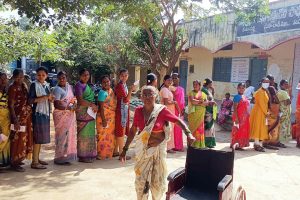Over the past few months, there has been a smear campaign against West Bengal and Bengalis. It is not based on facts and sounds like a horror story. And yet going by the statistics of the Government of India, there has been a silent resurrection of West Bengal. The state’s own tax revenues have increased by about 25 per cent combined with a four-fold hike in total capital expenditure in 2012-15. Capital expenditure on the social sector has risen over five-fold and this has been matched by a three-fold increase in capital spending on economic services.
The budget revenue deficit is down by three-quarters from 2012-15. Tax revenues have risen by about 50 per cent although there has been a marginal improvement in non-tax revenues. Against the national compound annual growth rate (CAGR) of GDP of 12.27 per cent, West Bengal’s CAGR stands at a creditable 14.27 per cent. Revenue recoveries measured by the buoyancy over the state’s own taxes have risen from 1.35 to 1.87. Taxes on sales, VAT, etc., indicate a CAGR of 12.79 per cent, stamp duty and registration fees at 13.39 per cent while state excise had a CAGR of 17.36 per cent.
While revenue expenditure has grown by about 50 per cent, the corresponding utilization in economic and social services by around 40 per cent and 150 per cent might point to expanded services by way of new colleges, schools, hospitals, etc. Has such focused expenditure improved human development indices? Development expenditure as percentage of aggregate expenditure has risen from 56.99 to 61.63 per cent, and is pitched favourably against the national average for non-special category states at 68.12 per cent. Social sector expenditure of 38.92 per cent against the national average of 36.50 per cent is yet another plus-point. Embedded in social sector spending is education at 19.57 per cent and health at 5.59 per cent; both outweigh the national average for non-special category states at 16.23 per cent and 5.04 per cent respectively.
During 2014-15, plan capital outlay mainly consisted of expenditure on roads and bridges (Rs 1262 crore), power projects (Rs 1068 crore), infrastructure in medical and public health (Rs 1065 crore), urban development (Rs 1007 crore), flood control projects (Rs 882 crore), housing (Rs 686 crore) and social security and welfare (Rs 626 crore). In social sector spending, the highest capital expenditures were for water supply, sanitation, housing and urban development that went up to 25.62 per cent of all expenditure during that year. Health and family welfare and agriculture rose by about 5 per cent each while capital expenditure on power and energy almost doubled.
Potable water now reaches 95.1 per cent of rural homes and 93.5 per cent of urban homes. Electricity lights up 97.2 per cent of urban and 95.1 per cent of rural homes. Literacy has also improved with 80 per cent of women and men in rural areas. Registration of births in rural Bengal is 97.3 per cent in urban and 96.7 per cent in rural areas. The state ranks in the fourth position with a birth rate of 15.5 against the national average of 20.8 in 2015.
The rural birth rate has fallen from 18.1 in 2011 to 17.3 in 2015, the rural death rate from 6.1 to 5.8 and rural infant mortality rate from 33 to 27. The state has a 33 per cent urban population. In fact, West Bengal has consistently indicated a rate that is five per cent less than the national average birth rate and a 0.6-0.8 negative with national death rate since 2004. The death rate has declined to 5.9 against the national average of 6.5, placing the state fifth in the list of top performing states. Here too, Bengal has consistently posted achievements of 18-11 less than the national average since 2004.
When the death and birth rates are offset one against the other, the result is 13.3 to 9, substantially lower than the national average. A MOHFW report projects that by 2025, West Bengal would boast life expectancy of 71 years for men and 74.3 years for women. This compares favourably with the estimated national average of 69.8 years and 74.3 years respectively. Similarly, the infant mortality rate is down to 26 against the national average of 37 (6th lowest). The total fertility rate has declined to 1.6, the lowest in India. Likewise neonatal maternity is down to 18 against the national average of 25 (7th lowest).
While the under- 5 mortality age has dropped to 30 (8th lowest) against the national average of 43, the maternal mortality ratio has fallen to 113 (6th lowest), against the national average of 167. The sex ratio stands at 950 against the national average of 943 in 2011. Interestingly, Bengal’s general fertility rate of 54.4 is way below the national average of 76.2, with only Kerala ahead of the state. What is even more creditable is the fact that the rural fertility rate of 60.6 is just two-third of the national average of 83.8. That education has engendered higher awareness of small family size is evident from the fact that the state boasts 62.3 live first births, 25.4 second births, 9.1 for third and 3.3 fourth born, against the national average of 48.6, 28.5, 13.4 and 9.4 respectively.
Gross enrollment ratio for primary and upper primary schools, that had stagnated around 85 per cent and 60-65 per cent up to 2010-11 increased to 87-90 per cent and 72-74 per cent in 2013-14 and 2014-15.
The improvement in the quality of key infrastructure has also been considerable. The total number of government-owned schools rose to 82737 in 2015-16 of which 73072 (88 per cent) were in rural areas (an increase of about 5 per cent over 2010-11), a tad below the national average of 92.90 per cent. State schools accounted for 86.40 per cent of all schools, against the national average of 74.20 per cent, down from a high of 90 per cent in 2010-11 (national average of 80 per cent) with a proportionate rise in the number of private schools.
The percentage of schools housed in their own buildings is up to cent per cent (national average of 99 per cent), 91 per cent of girls have access to toilets (national average of 94 per cent), 99 per cent have potable water supply, 96 per cent have electricity, 93 per cent have a library each. However, the pupilteacher and student-classroom ratios are a third above the national average, pointing to the need for more teachers and classrooms. MHRD’s National Achievement Survey (Class-III Cycle-3), 2016 states: “Performance of students of West Bengal is significantly above the national average in both language and there is no significant difference in mathematics”.
In language, the state’s children scored an impressive 271 against the national average of 255 while for mathematics the score was 255. The survey is complimentary when it says, “Performance of both boys and girls is higher than the national average in both language and mathematics .The largest proportion of students in the state scored 51-75 per cent correct answers in language. The majority of students in the state scored above 75 per cent correct answers in mathematics.”
The results were similar for students of Class 8. NSDP has doubled from Rs 5.55 lakh crore in 2011-12 to Rs 11.64 lakh crore in 2016-17 while per capita NSDP has also doubled from Rs 60082 to Rs. 120599, i.e. CAGR of 15 per cent. Agriculture, forestry and fisheries have increased in value by about 120 per cent (CAGR of 20 per cent). However, industrial CAGR has been modest at barely 8 per cent. Trade and services sector show a healthy CAGR of about 20 per cent each.
Evidently, closer monitoring has caused bed occupancy rate in medical college hospitals to rise from 92.9 in 2011 to 95.9 in 2016, district hospitals from 86.1 to 92.5, rural hospitals from 64 to 72 and block primary health centres from 55 to 65.2. West Bengal witnessed promising growth in the MSME category with an investment of Rs 8937 crore in 66246 new units opened during 2007-08 and 2011-12. Currently there are 108881 MSME units in the state providing employment opportunities to over ten lakh people in the state. Road-length has expanded from about 2.30 lakh km in 2008 to 3.10 lakh km in 2013, by about a third.
The state’s own installed capacity for power generation and actual generation has increased by 20 per cent since 2010-11 and transmission and distribution losses are below the national average of 25.60 per cent. However, West Bengal is a laggard with just 413 major projects worth Rs 1.69 lakh crore (3.30 per cent of the total) under implementation as on 30 April 2017, with neighboring Odisha faring better at Rs 1.75 lakh crore (3.50 per cent) and Chhattisgarh with Rs 1.98 lakh crore (3.90 per cent).
(The writer is a senior public policy analyst and commentator)










